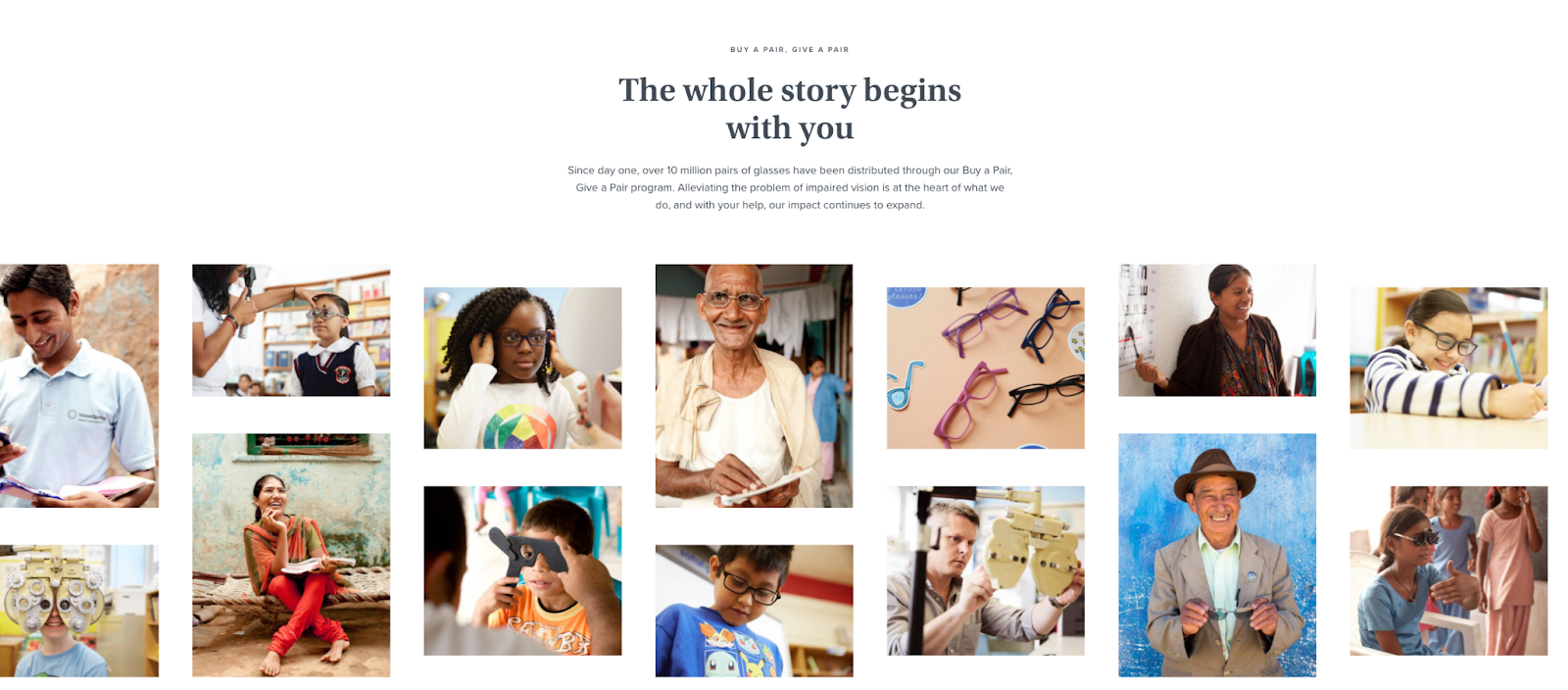Storytelling is how your brand espouses its values, connects with customers, and shares its contribution to the world.
Today, people don’t just want to buy from a brand—they want to connect with a brand. Especially for newer, smaller businesses, creating a meaningful connection with consumers not only presents a great opportunity, but it’s also necessary to success.
Gartner notes that effective narratives are now becoming essential to driving engagement.[1] And this is where brand storytelling comes in.
Below we’ll define brand storytelling, explain why it’s so impactful, and share the elements and resources a business needs to craft a compelling brand story of their own.
Should you be engaging in brand storytelling for your business?
What is brand storytelling?
Brand storytelling is the process of a business creating a narrative that appeals to customers’ empathy and values while also expressing the business’ own values, whom the business serves, the overall value proposition, and what the business does uniquely well.[1]
This goes beyond a mere marketing campaign and instead refers to the overall story told about your brand through every activity related to marketing and advertising. This includes mission statement, values, voice and tone, as well as the type of messaging you use both online and off.

A screenshot from Warby Parker’s Buy a Pair, Give a Pair webpage[2]
One particularly impactful example of brand storytelling comes from eyeglass manufacturer Warby Parker. Their Buy a Pair, Give a Pair initiative is an excellent example of the power of storytelling to further a business’ mission while also making an impact on the world at large through sustainable marketing.
Related:
If you have room in your tech stack, social listening tools can be a great way to gauge community sentiment over time.
Why is brand storytelling so impactful?
Brand storytelling is impactful because it involves a multidimensional view of the customer, including their personal values and pivotal moments within their customer experience.
A good brand story takes into account not only what they are trying to accomplish as a business and how they are going about it but also why that matters to their target audience—both from a values and a value proposition perspective.
An engaging brand narrative can create positive brand associations through espousing a business’ moral and ethical virtues, it can build brand loyalty through connecting with a target audience, and it can also let people feel seen as individuals (and not merely consumers).
This is especially important in today’s landscape, where technology like AI and machine learning are creating more and more believably human content every day. To achieve true authenticity, a brand’s story must have a real human element imbued into it. This type of care in crafting a narrative will help the story resonate with customers beyond what a data-driven approach can provide.
Aside from creating a strong connection with customers, a brand’s story can also drive decision making. For Matt Addison, founder of athleisure brand Rugged Black[3], his brand story is his bedrock:
“Every future decision you make should be informed by your values which are anchored by your story.”


Matt Addison
Who stands to benefit the most from brand storytelling?
Regardless of the industry a business is in, they still stand to benefit from good storytelling. While businesses with subject matter that lends itself well to storytelling (sustainability, supporting a cause, etc.) have an easier time getting started, industries that could be considered “dryer” can use storytelling early on to gain awareness and get ahead of the competition.
Budget also comes into play as the tactics typically associated with brand storytelling are based in advertising. However, there are things businesses with a smaller marketing budget can do as well. For starters, seek to understand what’s truly important to your customers then align your business with those values to make them a driving force in your brand story.
Focus on customer insights gleaned from social media, physical locations if you have them, or really anywhere your community resides. Find them, listen to them, and help them feel seen! Then use those insights to strengthen your story. This can be done regardless of industry or the size of your business, and all you need is a willingness to listen.
Related:
If you have room in your tech stack, social listening tools can be a great way to gauge community sentiment over time.
The elements of a compelling brand story
Crafting a compelling brand story can be accomplished using many different elements. Good stories can be empathetic, authentic, relatable, attention grabbing, or humorous (and more). Regardless of the tone and voice of your business, connecting with your audience throughout their customer journey in ways that provoke action is the goal.
To successfully link components of the narrative together, target those components at specific points in the customer journey.[1] This can be achieved by connecting universal narrative elements with the facets of marketing that they support:
Characters (customer personas)
Stories are generally based on a handful of key characters and their perspectives, agendas, and priorities. Identify your business’ core characters in a marketing context to outline your buyer personas. These personas will act as the central figures in your narrative, with their motivations driving the story (or the customer experience in this case). For Addison and many other business owners, “the hero is the customer.”
Understanding each persona’s “why” will help you anticipate how key decisions will be made (and where action will be taken) along your business’ customer journey.
Setting (customer journey context)
Just like the characters and the plot, the setting plays a key role in any successful story. From a marketing context, the setting represents the industry your business resides in, the challenges consumers face when choosing your type of product or service, and any considerations arising from logistical realities or the competition you face.
Understanding how the customer’s place in that environment plays a role in their decision making will let you craft a business narrative that addresses that decision making process in the right way at the right time. And remember: The setting is not static. Industry developments and consumer behaviors can change.
Plot (story of the customer experience)
Plot is how characters interact with their environment, each other, and the evolving circumstances they find themselves in. In combination with all the other elements outlined here, the plot is really the crux of the story you want to tell and the customer experience you want to offer.
Customer needs, desires, and values will drive the plot with your marketing messages and activities shaping and supporting that story. This type of specificity and attention to detail is what separates a mere value proposition from a full-fledged brand story that deftly interweaves the customer experience with a business’ mission.
Conflict (objections and resistance)
Every story has some sort of central conflict. In the case of the buyer journey, this conflict can come in the form of a consumer resisting the solution a business presents, lack of urgency to solve their problem, or an active interest in a competitor’s solution. Regardless of the source of these conflicts, openly understanding and addressing them is crucial to creating a compelling story.
Resolution (solution)
For a business, the resolution to the customer journey is (hopefully) conversion. Set the stage by identifying your main characters using buyer personas, properly tend to the setting and conflicts those characters find themselves in, and develop a plot where potential customers feel seen as individual people—not just a mass of consumers. If you can exceed your customers’ needs in this way to make them feel truly considered, your brand story is bound to have a happy ending. For Addison, that comes in the form of proactive positive feedback:
“When someone feels the need to reach out personally and have that connection… you know you’ve done something that’s not just sales.”
Matt Addison
Resources needed to tell a compelling story of your own
There can be a high perceived cost when it comes to storytelling since a lot of tactics center around advertising (and budget). However, there are actions any business can take today to get started:
(Re)align on your values: It may have been a while since you last put pen to paper on your business’ values. Take the time to gather your teammates and review, spruce up, or create a mission statement, list of values, and/or brand essence.
Focus on customer insights: A good brand story is entirely customer driven. Whether it’s through collecting info at physical locations, social media, or software like social listening tools, find your community and gather insights!
Audit your tech stack for brand cohesion: You don’t always have to start off with specialized brand management software to get the ball rolling with your brand story. Look at the software you do have—content repositories, presentation software, social media management tools, etc.—and make sure that all the branding elements contained therein are accurate and cohesive.
Once you’ve visited these areas and feel confident about your branding essentials, it may be time to bring in outside help in the form of a branding agency. These organizations can work with you to connect the dots, discover things you may have missed, or further strengthen your story for the long run.
Related:
If you’re curious about what a branding agency can do for your business, visit the Capterra Branding Agency Hiring Guide to learn about the benefits, cost, and when to consider hiring an agency of your own.
Looking for specific location-based agencies? We've got you covered.
Finding what makes your business connect with people on an individual level and exploring that to create a compelling brand story is the essence of marketing authenticity. Any business can stand to benefit from brand storytelling, but for some it’s easier than others. Luckily, you should now be well prepared to begin writing your own brand story with the insights and tips above.
For more on branding, marketing, and all things digital, visit the Capterra blog and start with these resources:
